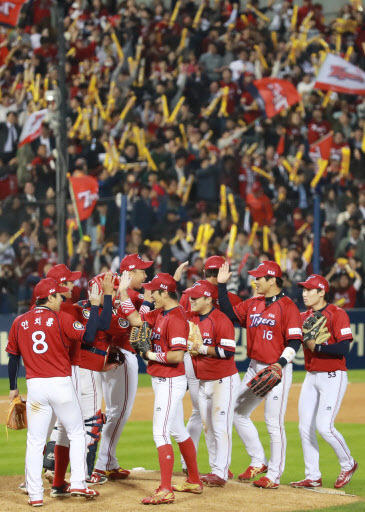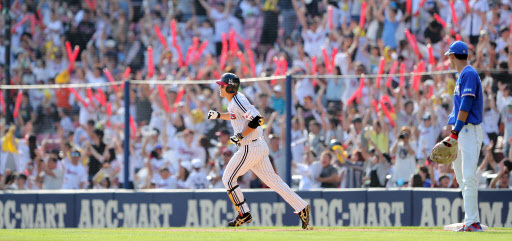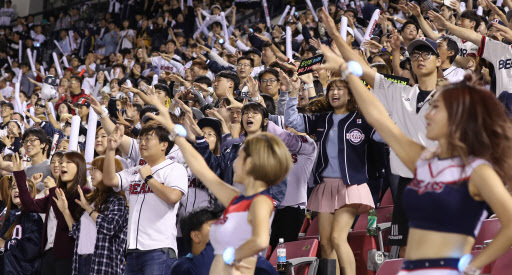Spectators come in representative colors. Electrically amplified cheering and sing-alongs by fans of each team echo throughout ball parks. Cheerleaders, dancing along to K-pop hits during the breaks, wow the tens of thousands in the crowd.
The cheering culture of South Korean baseball fans can be overwhelming -- something akin to the overflowing emotions pioneered by the high-profile cheering squad at the 2002 Korea-Japan World Cup. Back then, a number of Korean soccer fans clad in trademark red shirts often gathered in Seoul Plaza to support the national team.
The cheering culture of South Korean baseball fans can be overwhelming -- something akin to the overflowing emotions pioneered by the high-profile cheering squad at the 2002 Korea-Japan World Cup. Back then, a number of Korean soccer fans clad in trademark red shirts often gathered in Seoul Plaza to support the national team.

One noticeable feature at Korean ball games is the sheer volume of cheering. In fact, loudness seems vital as many Korean fans believe ear-splitting sounds can drive a batter to hit further.
Park Ki-hwan, 26, has been a fan of Seoul-based professional baseball team LG Twins since he was in third grade. He said he was amused by the resounding cheers from his first visit.
“It was more entertaining than anything else,” said Park. “And I believe such a loud volume will have a positive effect on our players.”
Playfulness is another important element that define the country’s baseball cheering culture. Some fans make noise in hopes of players hitting a home run. Others generate a repetitive harmony of balloon clappers in unison. Songs representing players are played and sung together. A male cheerleader is seen hollering at spectators, using a drum and microphone.
Other than entrance music -- a segment of original music representing a player -- Korean fan communities assign batters specific songs, arranged by cheerleaders, with some lyrics changed.
Once the songs are out at the official fan page run by the team, fans can download them and sing-along later at the venue when they come through speakers.
Park Ki-hwan, 26, has been a fan of Seoul-based professional baseball team LG Twins since he was in third grade. He said he was amused by the resounding cheers from his first visit.
“It was more entertaining than anything else,” said Park. “And I believe such a loud volume will have a positive effect on our players.”
Playfulness is another important element that define the country’s baseball cheering culture. Some fans make noise in hopes of players hitting a home run. Others generate a repetitive harmony of balloon clappers in unison. Songs representing players are played and sung together. A male cheerleader is seen hollering at spectators, using a drum and microphone.
Other than entrance music -- a segment of original music representing a player -- Korean fan communities assign batters specific songs, arranged by cheerleaders, with some lyrics changed.
Once the songs are out at the official fan page run by the team, fans can download them and sing-along later at the venue when they come through speakers.

The roaring sound is not limited to a favorite team or players. For example, a quick bark of “Ma” -- meaning “Do not” in Korean -- by spectators supporting Busan-based Lotte Giants is used to discourage an opposing pitcher from attempting to pick off Giants’ runner at the first base.
The 26-year-old Park asserted such loud cheering helps the fans feel a sense of belonging.
“The moment of victory will come with a victory chant, and spectators will sing it while swaying shoulder to shoulder, regardless of whether they know each other or not,” he said.
The unity of Korean spectators is not only audible but also visible.
The same colored uniforms and balloon clappers make up the team identity. Fans of professional baseball teams tend to follow the tradition of gathering together at seats in the first base side, except for Gwangju-based Kia Tigers and Daegu-based Samsung Lions, where home fans take the third base side. Each side has a small stage and speakers in front of the second-tier seats. If fans do not know how to move balloon clappers, they watch a group of cheerleaders’ gestures and follow suit.
The 26-year-old Park asserted such loud cheering helps the fans feel a sense of belonging.
“The moment of victory will come with a victory chant, and spectators will sing it while swaying shoulder to shoulder, regardless of whether they know each other or not,” he said.
The unity of Korean spectators is not only audible but also visible.
The same colored uniforms and balloon clappers make up the team identity. Fans of professional baseball teams tend to follow the tradition of gathering together at seats in the first base side, except for Gwangju-based Kia Tigers and Daegu-based Samsung Lions, where home fans take the third base side. Each side has a small stage and speakers in front of the second-tier seats. If fans do not know how to move balloon clappers, they watch a group of cheerleaders’ gestures and follow suit.

Colors are not the only things that divide each side. When their team is winning, Lotte Giants’ fans put on headgear made of a plastic bag with some air in.
To non-Korean baseball fans, this distinctive cheering culture might come off as a barrier. Paul Ahn, 25, was a Cardinals fan when he was studying overseas in St. Louis. His impression was that the Korean way of cheering does not appear to offer an “open invitation” to match-goers.
“The Korean way (of cheering) is more exciting, while the American way is more admiring, making it easier for people to join in,” he said. “Those who are not familiar won’t pick it up easily.”
By Son Ji-hyoung (json@heraldcorp.com)
To non-Korean baseball fans, this distinctive cheering culture might come off as a barrier. Paul Ahn, 25, was a Cardinals fan when he was studying overseas in St. Louis. His impression was that the Korean way of cheering does not appear to offer an “open invitation” to match-goers.
“The Korean way (of cheering) is more exciting, while the American way is more admiring, making it easier for people to join in,” he said. “Those who are not familiar won’t pick it up easily.”
By Son Ji-hyoung (json@heraldcorp.com)






![[KH Explains] How should Korea adjust its trade defenses against Chinese EVs?](http://res.heraldm.com/phpwas/restmb_idxmake.php?idx=644&simg=/content/image/2024/04/15/20240415050562_0.jpg&u=20240415144419)











![[Today’s K-pop] Stray Kids to return soon: report](http://res.heraldm.com/phpwas/restmb_idxmake.php?idx=642&simg=/content/image/2024/04/16/20240416050713_0.jpg&u=)